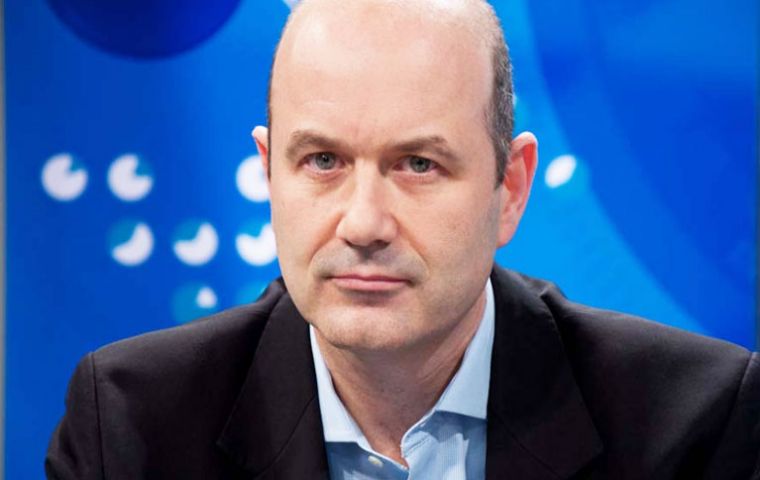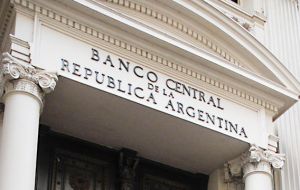MercoPress. South Atlantic News Agency
Billions pour in to buy Argentine bonds, “sign of growing investor confidence”
 The milestone, according to Central Bank chief Federico Sturzenegger, was “a sign of growing investor confidence in the country.”
The milestone, according to Central Bank chief Federico Sturzenegger, was “a sign of growing investor confidence in the country.”  Foreign reserves rose to US$40.6 billion, the Argentine Central Bank reported, their first time above the US$40 billion mark since April 2013.
Foreign reserves rose to US$40.6 billion, the Argentine Central Bank reported, their first time above the US$40 billion mark since April 2013.  That marked a 63% increase from US$24.9 billion on December 2010, the date of President Mauricio Macri’s inauguration, according to the monetary authority.
That marked a 63% increase from US$24.9 billion on December 2010, the date of President Mauricio Macri’s inauguration, according to the monetary authority. Argentina’s international currency reserves rose above the landmark US$40 billion for the first time in three and a half years last Friday, as a huge inflow of dollars from government-issued debt and some exports over the last few days caused some dramatic increases this week. The milestone, according to Central Bank chief Federico Sturzenegger, was “a sign of growing investor confidence in the country.”
Foreign reserves rose to US$40.6 billion, the Argentine Central Bank reported, their first time above the US$40 billion mark since April 2013. That marked a 63% increase from US$24.9 billion on December 2010, the date of President Mauricio Macri’s inauguration, according to the monetary authority.
A large part of that increase has come from loans to the Central Bank and bonds raised by the Treasury. Those dollars are counted as part of the Central Bank’s reserves.
The devaluation in December 2015 also helped boost the reserves as it pushed grain exporters sell the produce they were hoarding, bringing more dollars into Argentina.
With Argentina unable to borrow on international markets after a record 2002 default, dwindling reserves during the Cristina Fernández administration raised the specter of a balance-of-payments crisis. The government restricted imports and foreign currency transactions since 2012 in order to try to keep reserves without resorting to a devaluation that would hit purchasing power, but reserves kept decreasing.
Macri ended currency controls and let the Argentine peso float shortly after taking office, and settled a legal dispute with US hedge funds, paving the way for the country to return to global capital markets with its US$16.5 billion sovereign debt sale in April, ending concerns about financing sources by re-entering global bond markets.
“I have insisted that the level of reserves is not very relevant. But the fact that they’ve risen above US$40 billion says something about growing confidence in the country,” Federico Sturzenegger said on Twitter.
According to Sturzenegger, the main concern of the Central Bank should be to sustain the value of the peso by printing less pesos. To achieve that, the Treasury has vowed not to ask for so many pesos from the Central Bank to finance its fiscal deficit. Instead, it is raising debt abroad and has promised to cut the deficit in the coming four years.
Inflation over the last 12 months has been close to 40% after a spike following December’s lifting of the so-called “clamp” on foreign currency transactions, leading to a loss of purchasing power.
Over the last few months, although Argentina is still in a recession, inflation has slowed down (Sturzenegger is targeting 17% next year), leading officials to argue that this was evidence of the country being on the right path.
The Argentine Treasury managed to raise 76.4 billion Argentine Pesos in the market. This was made up of 53.6bn Pesos in a ten year bond with a fixed rate of 15.5%, while the rest was raised with a 7 year bond also at a 15.5% rate.
According to the Argentine government this “historic” sum was possible because an estimated US$ 3.8bn from international foreign investors came into Argentina. Government plans to finance half the fiscal budget of the fourth quarter.




Top Comments
Disclaimer & comment rules-

-

-

Read all comments“ the low levels of indebtedness left by the CFK government.”
Oct 25th, 2016 - 08:58 pm +3Actually the CFK government ended with more debt than it started with, and essentially emptied the coffers as it left. The Secretaría de Finanzas numbers show that during the last KK year, 2015, the national debt here grew by US$18.3 billion, which represented more than 45% of the gross national product. But the KK followers still believe the myth of some sort of “desendeudamiento.”
The KK also left another sort of debt, in the form of low-value make-work projects underway for which there were no funding sources, as well as leaving sectors such as Aerolineas operating in enormous debt, and much of the infrastructure in near-ruins. Another expensive legacy of the KK era involves the high taxation costs we still have here.
The erosion of buying power now is essentially the same as that which existed during the KK era, with about the same inflation and wage-adjustment rates, though the latter varies by sector. The decline of the PYMEs has been underway for a long time and is the result of many factors, including their own inefficiencies and lack of adaptation for competitiveness, and low worker productivity. But the PMYEs also suffer from high labour costs that resulted from the KK governments, a regional recession, high levels of taxation, and the burdens of bureaucracy, crime, and corruption. We still have a VAT of 21 percent and employers pay a social security tax of 27 percent, which discourages hiring of new employees. Very little has changed that is providing near-term benefits and I still expect a “significant nonpayment event” involving foreign debt, within 5 years. Argentina isn't going anywhere, and it doesn't matter who is running the current show.
Billions pour in to buy Argentine bonds,
Oct 24th, 2016 - 08:12 pm +1Shaken but not stirred, and debts to be repaid.
article: “ According to the Argentine government this “historic” sum was possible because an estimated US$ 3.8bn from international foreign investors came into Argentina. ”
Oct 24th, 2016 - 08:26 pm +1--- Then the government is lying again. So far this year more than US$20 billion has been raised from bond sales on the international market, and those “ dollar reserves” are needed to cover the increasing high-interest debt that Argentina has taken on. An earlier set of dollar-denominated treasury bonds here this year are paying 18 percent interest and a more recent issue is at more than 15 percent. And then there is the additional euro-denominated debt this year. Ask yourself where Argentina is going to get the money to service that sort of interest while it is paying foreign journalists to hype the apparent dollars looking like “reserves” in the central bank here.
All while the country is making no real progress in actually producing additional goods and services, while poor productivity and high tax rates coupled with the effects of corruption, deteriorated infrastructure, and bureaucracy are stifling any chances for improved competitiveness. They're probably expecting some sort of deus ex machina.
Commenting for this story is now closed.
If you have a Facebook account, become a fan and comment on our Facebook Page!